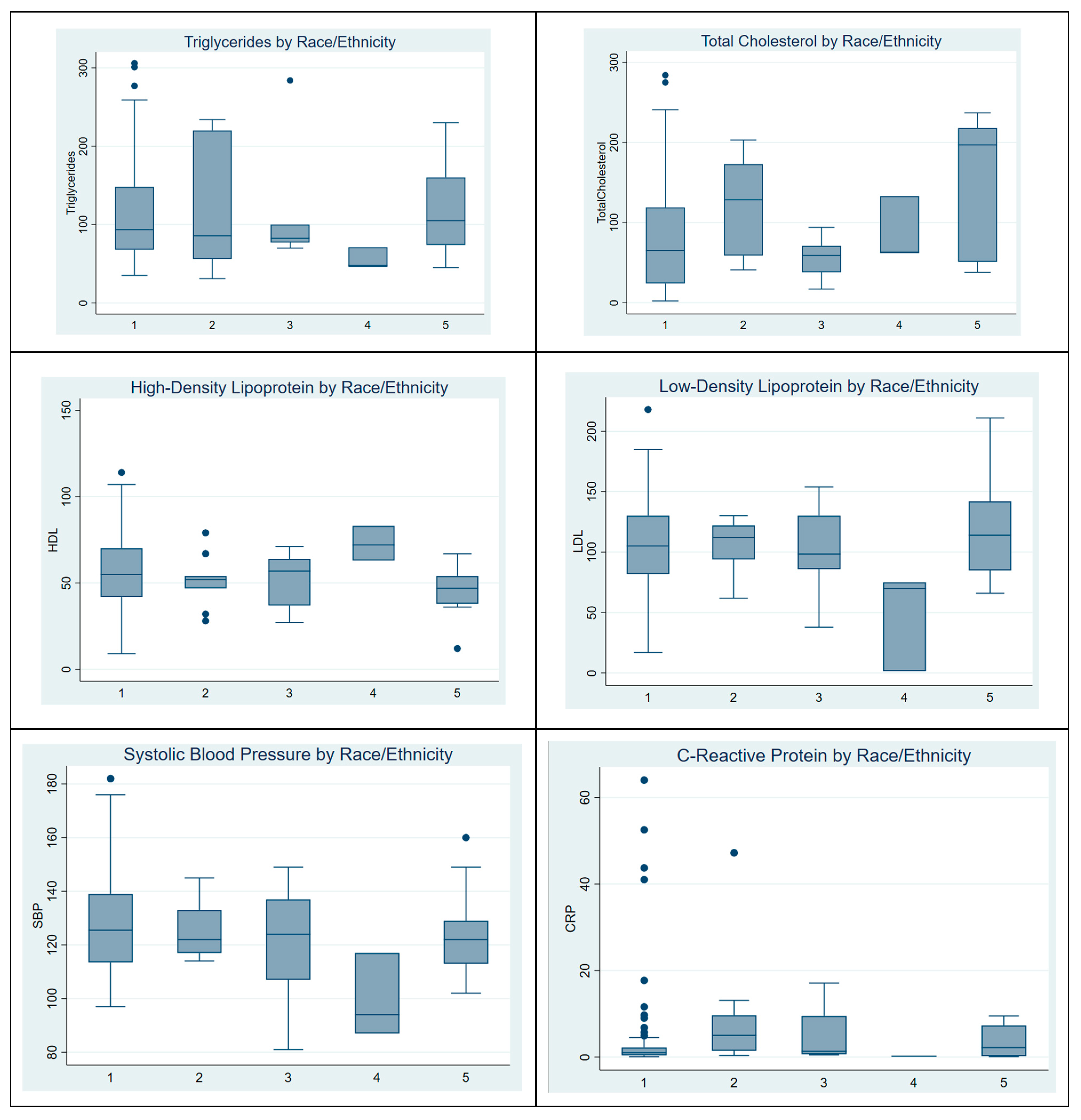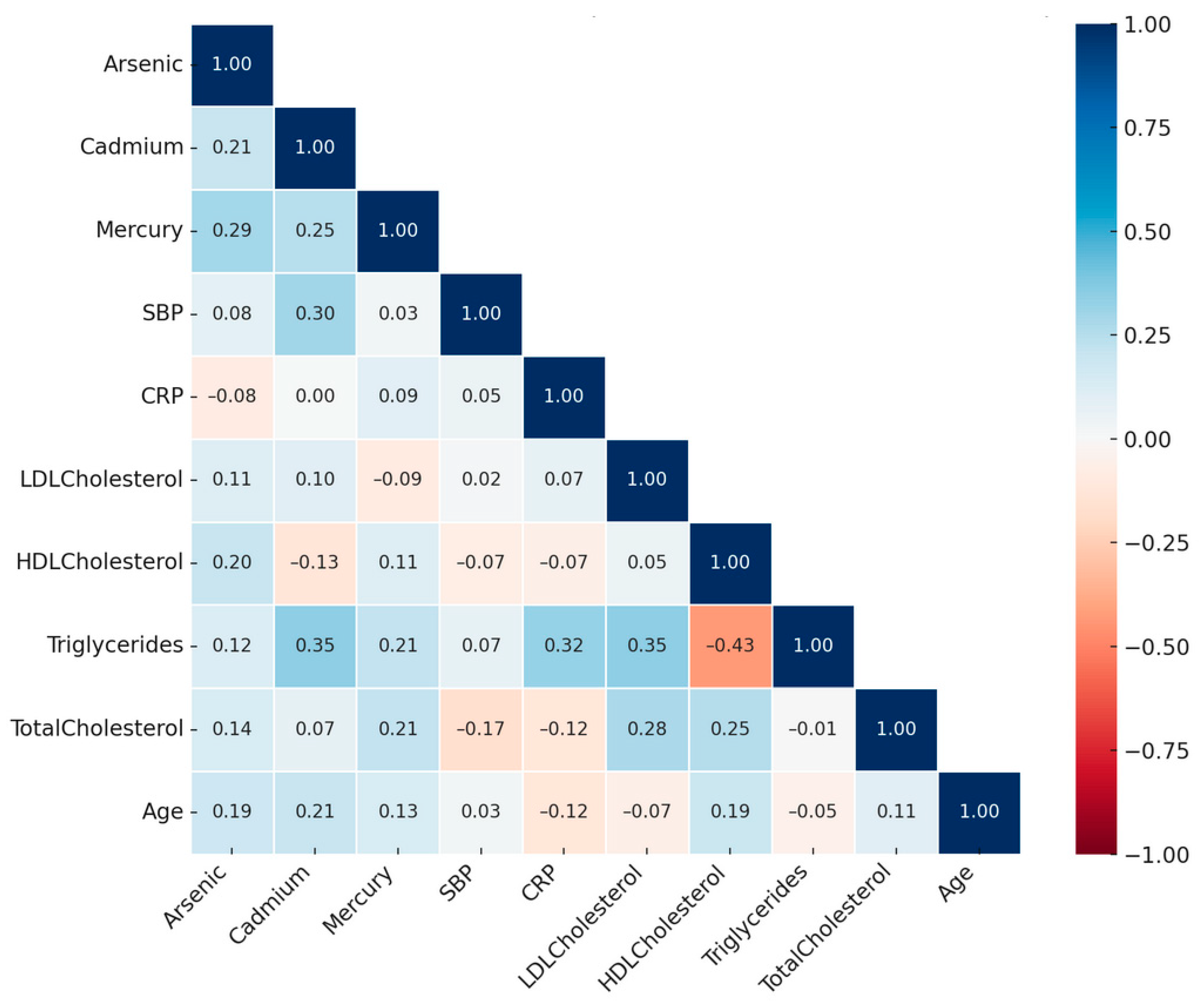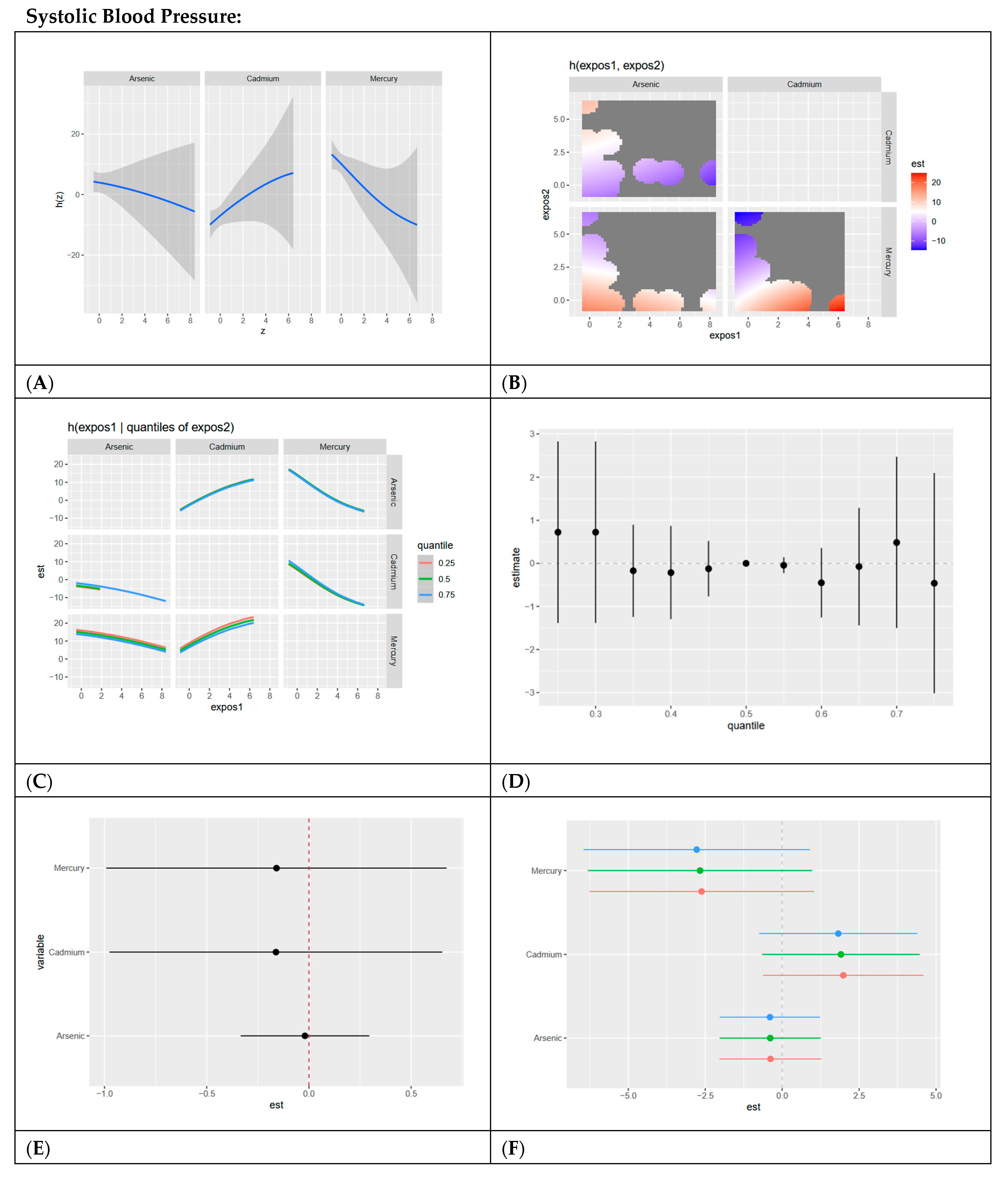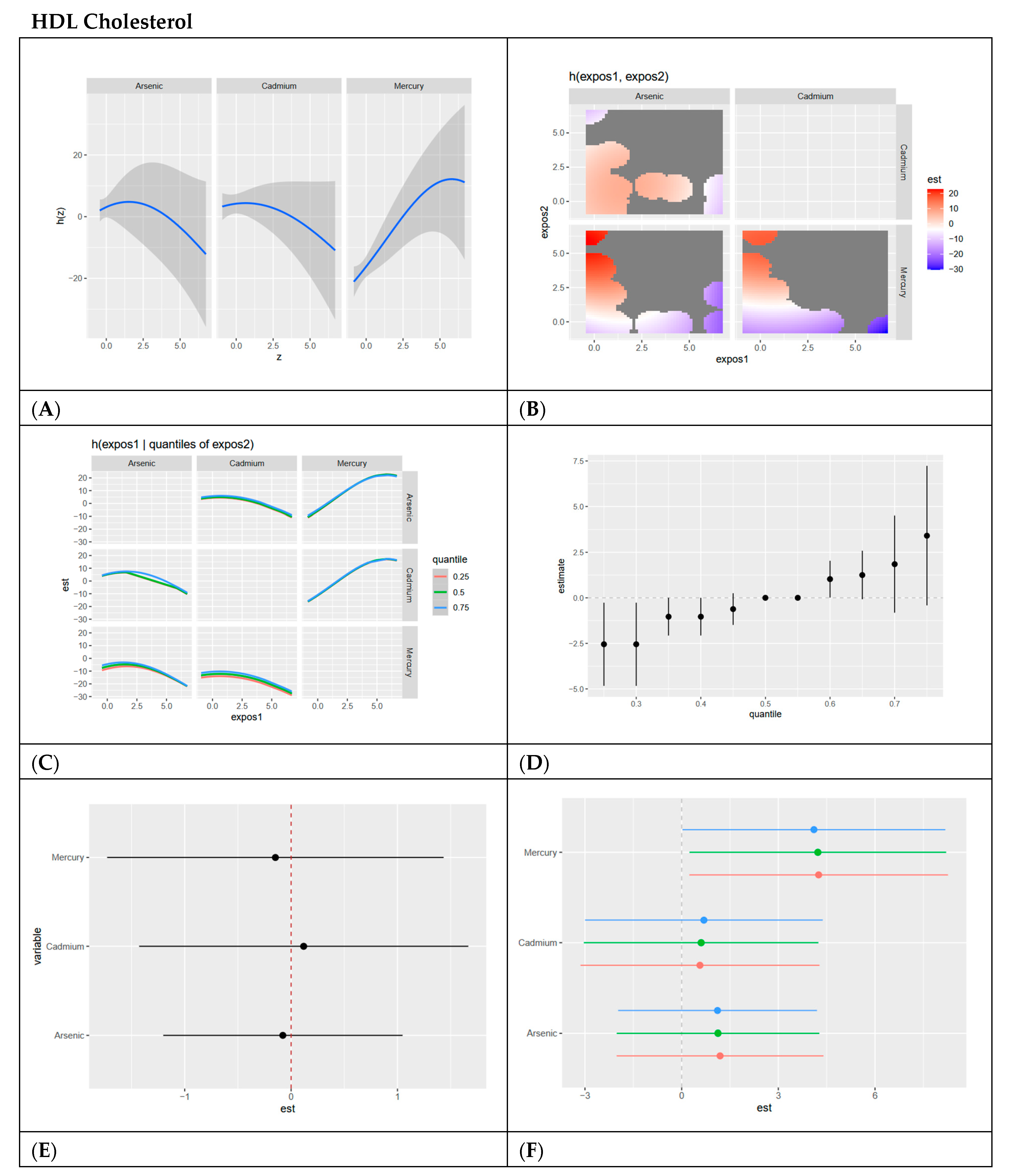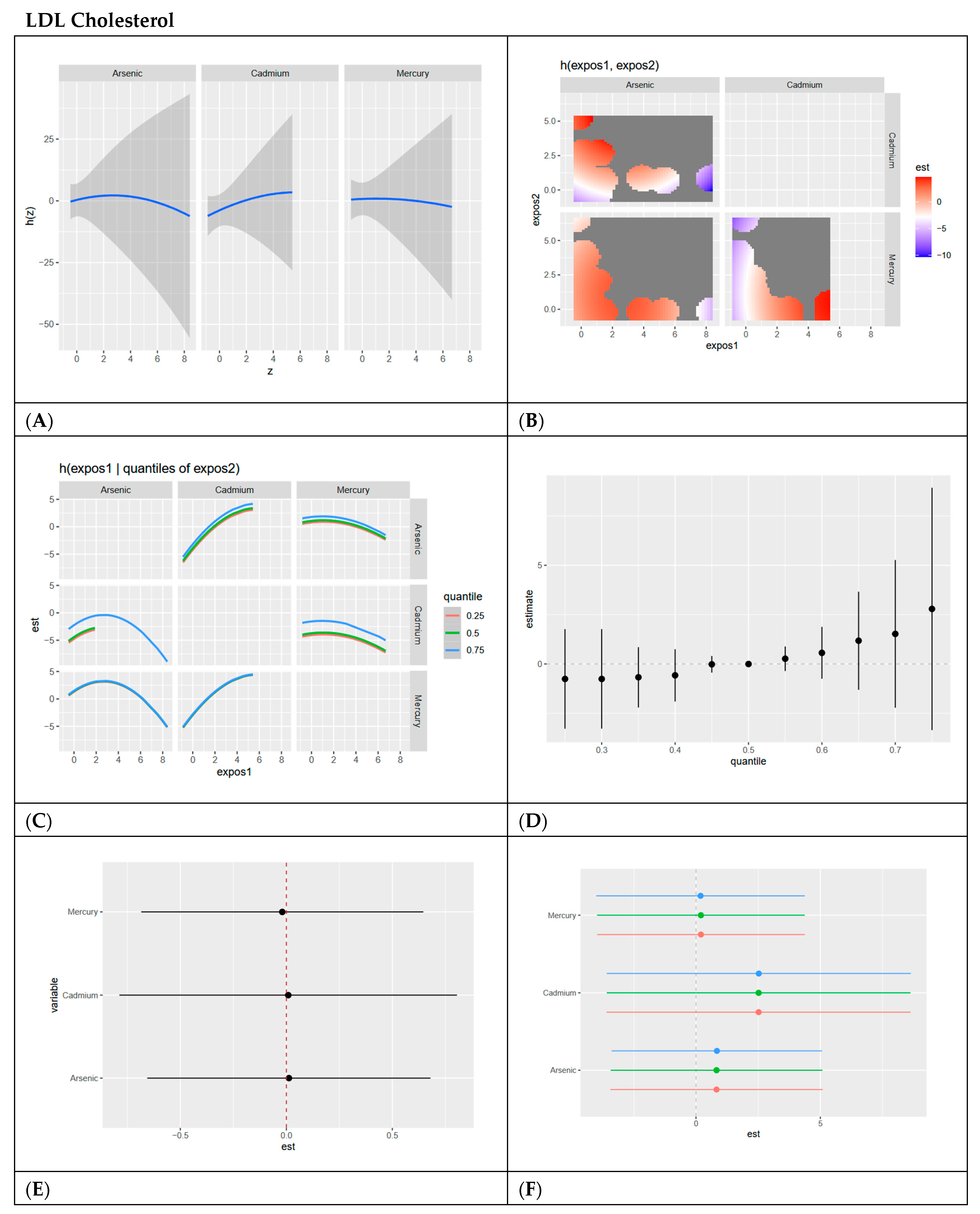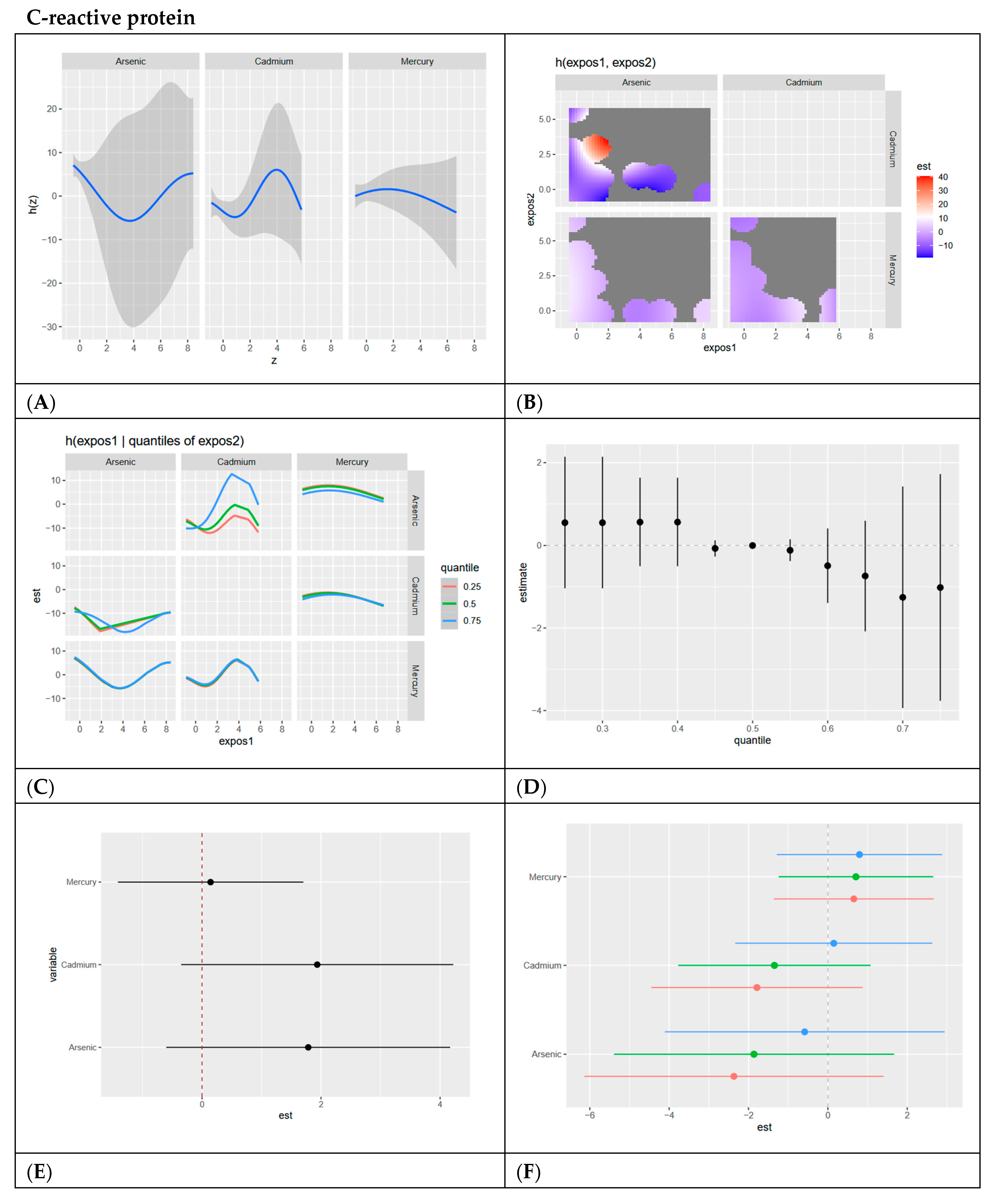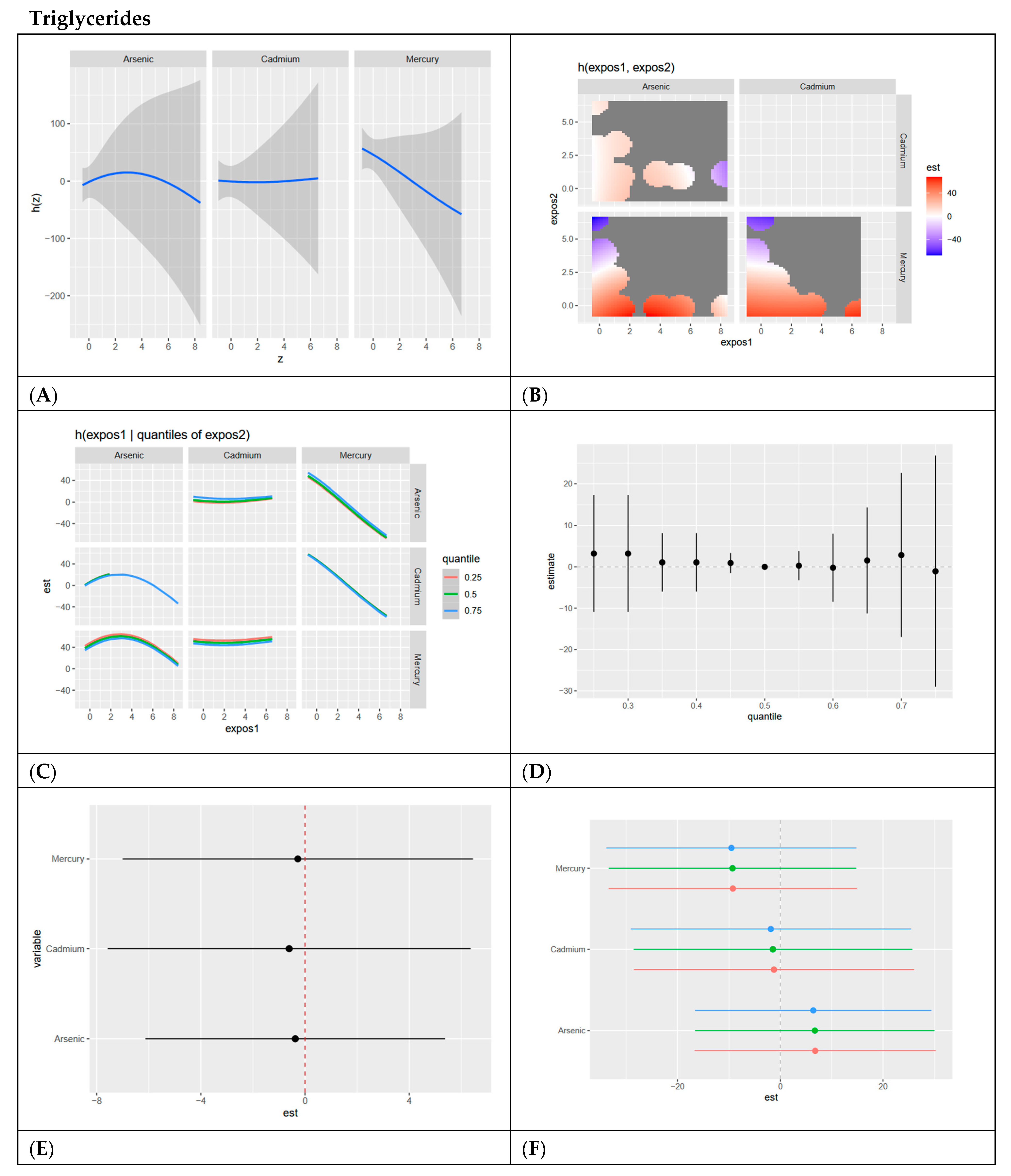Figure 1.
Distribution of heart health metrics by race/ethnicity.
Figure 1.
Distribution of heart health metrics by race/ethnicity.
Figure 2.
Spearman correlation matrix of heart health metrics and environmental exposures.
Figure 2.
Spearman correlation matrix of heart health metrics and environmental exposures.
Figure 3.
BKMR results for systolic blood pressure. (A) Univariate exposure–response functions with 95% credible intervals for the association between metal/metalloid exposures (arsenic, cadmium, and mercury) and systolic blood pressure, with other metal exposures fixed at the median. Analyses are adjusted for age, sex, ethnicity, and race. Results show a linear, slightly negative relationship for arsenic and mercury and a linear, positive relationship for cadmium. (B) Bivariate exposure–response functions illustrating the joint association of metal exposures with systolic blood pressure. Analyses are adjusted for age, sex, and race. Results show a strong joint association between high mercury and low cadmium levels, low mercury and arsenic across all exposure levels, and high cadmium and low mercury. (C) Bivariate exposure–response functions exploring the predictor–response relationships while varying quantiles (25th, 50th, 75th percentiles) of a second predictor, with all other exposures fixed. Analyses are adjusted for age, sex, and race. Results show a linear, slightly positive association between cadmium and other metals/metalloids at all exposure levels, with mercury and arsenic having slightly negative linear associations. (D) Summary of overall health effects and 95% credible intervals of combined metal/metalloid exposures on systolic blood pressure at various quantiles, ranging from the 25th to the 75th percentiles. Analyses are adjusted for age, sex, and race. Results show no clear pattern at increasing quantiles. (E) Single-variable interaction terms and 95% credible intervals for metals, comparing the effect of each metal exposure when all other metals are fixed at the 75th percentile compared to the 25th percentile. Analyses are adjusted for age, sex, and race. Results show minimal interaction between each metal/metalloid and combined exposure to other metals/metalloids. (F) Single-exposure attributable effects and 95% credible intervals, representing the change in systolic blood pressure associated with a change in a specific exposure (metal/metalloid) from its 25th to its 75th percentile, with all other exposures fixed at quantiles of 0.25 (red), 0.50 (green), or 0.75 (blue). Analyses are adjusted for age, sex, and race. Results show cadmium has the strongest positive effect, with minimal interaction demonstrated for all exposures as evidenced by red, green, and blue dots essentially overlapping.
Figure 3.
BKMR results for systolic blood pressure. (A) Univariate exposure–response functions with 95% credible intervals for the association between metal/metalloid exposures (arsenic, cadmium, and mercury) and systolic blood pressure, with other metal exposures fixed at the median. Analyses are adjusted for age, sex, ethnicity, and race. Results show a linear, slightly negative relationship for arsenic and mercury and a linear, positive relationship for cadmium. (B) Bivariate exposure–response functions illustrating the joint association of metal exposures with systolic blood pressure. Analyses are adjusted for age, sex, and race. Results show a strong joint association between high mercury and low cadmium levels, low mercury and arsenic across all exposure levels, and high cadmium and low mercury. (C) Bivariate exposure–response functions exploring the predictor–response relationships while varying quantiles (25th, 50th, 75th percentiles) of a second predictor, with all other exposures fixed. Analyses are adjusted for age, sex, and race. Results show a linear, slightly positive association between cadmium and other metals/metalloids at all exposure levels, with mercury and arsenic having slightly negative linear associations. (D) Summary of overall health effects and 95% credible intervals of combined metal/metalloid exposures on systolic blood pressure at various quantiles, ranging from the 25th to the 75th percentiles. Analyses are adjusted for age, sex, and race. Results show no clear pattern at increasing quantiles. (E) Single-variable interaction terms and 95% credible intervals for metals, comparing the effect of each metal exposure when all other metals are fixed at the 75th percentile compared to the 25th percentile. Analyses are adjusted for age, sex, and race. Results show minimal interaction between each metal/metalloid and combined exposure to other metals/metalloids. (F) Single-exposure attributable effects and 95% credible intervals, representing the change in systolic blood pressure associated with a change in a specific exposure (metal/metalloid) from its 25th to its 75th percentile, with all other exposures fixed at quantiles of 0.25 (red), 0.50 (green), or 0.75 (blue). Analyses are adjusted for age, sex, and race. Results show cadmium has the strongest positive effect, with minimal interaction demonstrated for all exposures as evidenced by red, green, and blue dots essentially overlapping.
![Ijerph 22 00239 g003]()
Figure 4.
BKMR results for HDL cholesterol. (A) Univariate exposure–response functions with 95% credible intervals for the association between metal exposures (arsenic, cadmium, and mercury) and HDL cholesterol, with other metal exposures fixed at the median. Analyses are adjusted for age, sex, ethnicity, and race. Results show a slightly inverted U shapes for all three exposures with arsenic and cadmium decreasing as dose increases and mercury increasing as dose increases. (B) Bivariate exposure–response functions illustrating the joint association of metal exposures with HDL cholesterol. Analyses are adjusted for age, sex, and race. Results show a strong association between low arsenic and high mercury; arsenic, and mercury show a positive relationship across many exposure levels, with high mercury and low cadmium demonstrating strong associations. (C) Bivariate exposure–response functions exploring the predictor–response relationships while varying quantiles (25th, 50th, 75th percentiles) of a second predictor, with all other exposures fixed. Analyses are adjusted for age, sex, and race. Results show relatively flat semilinear curves for arsenic and cadmium with other exposures, with a positive linear curve for mercury with other exposures at the 0.75 quantile. (D) Summary of overall health effects and 95% credible intervals of metal exposures on HDL cholesterol at various quantiles, ranging from the 25th to the 75th percentiles. Analyses are adjusted for age, sex, and race. Results show a positive trend at increasing quantiles when exposed to all metals/metalloids. (E) Single-variable interaction and 95% credible intervals terms for metals, comparing the effect of each metal exposure when all other metals are fixed at the 75th percentile compared to the 25th percentile. Analyses are adjusted for age, sex, and race. Results show minimal interaction between each metal/metalloid and combined exposure to other metals/metalloids. (F) Single-exposure attributable effects and 95% credible intervals, representing the change in HDL cholesterol associated with a change in a specific exposure from its 25th to its 75th percentile, with all other exposures fixed at quantiles of 0.25 (red), 0.50 (green), or 0.75 (blue). Analyses are adjusted for age, sex, and race. Results show mercury has the most positive effect with minimal interaction for each exposure with other combined exposures, as demonstrated by red, green, and blue dots essentially overlapping.
Figure 4.
BKMR results for HDL cholesterol. (A) Univariate exposure–response functions with 95% credible intervals for the association between metal exposures (arsenic, cadmium, and mercury) and HDL cholesterol, with other metal exposures fixed at the median. Analyses are adjusted for age, sex, ethnicity, and race. Results show a slightly inverted U shapes for all three exposures with arsenic and cadmium decreasing as dose increases and mercury increasing as dose increases. (B) Bivariate exposure–response functions illustrating the joint association of metal exposures with HDL cholesterol. Analyses are adjusted for age, sex, and race. Results show a strong association between low arsenic and high mercury; arsenic, and mercury show a positive relationship across many exposure levels, with high mercury and low cadmium demonstrating strong associations. (C) Bivariate exposure–response functions exploring the predictor–response relationships while varying quantiles (25th, 50th, 75th percentiles) of a second predictor, with all other exposures fixed. Analyses are adjusted for age, sex, and race. Results show relatively flat semilinear curves for arsenic and cadmium with other exposures, with a positive linear curve for mercury with other exposures at the 0.75 quantile. (D) Summary of overall health effects and 95% credible intervals of metal exposures on HDL cholesterol at various quantiles, ranging from the 25th to the 75th percentiles. Analyses are adjusted for age, sex, and race. Results show a positive trend at increasing quantiles when exposed to all metals/metalloids. (E) Single-variable interaction and 95% credible intervals terms for metals, comparing the effect of each metal exposure when all other metals are fixed at the 75th percentile compared to the 25th percentile. Analyses are adjusted for age, sex, and race. Results show minimal interaction between each metal/metalloid and combined exposure to other metals/metalloids. (F) Single-exposure attributable effects and 95% credible intervals, representing the change in HDL cholesterol associated with a change in a specific exposure from its 25th to its 75th percentile, with all other exposures fixed at quantiles of 0.25 (red), 0.50 (green), or 0.75 (blue). Analyses are adjusted for age, sex, and race. Results show mercury has the most positive effect with minimal interaction for each exposure with other combined exposures, as demonstrated by red, green, and blue dots essentially overlapping.
![Ijerph 22 00239 g004]()
Figure 5.
BKMR results for LDL cholesterol. (A) Univariate exposure–response functions with 95% credible intervals for the association between metal exposures (arsenic, cadmium, and mercury) and LDL cholesterol, with other metal exposures fixed at the median. Analyses are adjusted for age, sex, ethnicity, and race. Results show relatively flat curves for all exposures. (B) Bivariate exposure–response functions illustrating the joint association of metal exposures with LDL cholesterol. Analyses are adjusted for age, sex, and race. Results show a strong positive relationship between arsenic and cadmium at most exposure levels, with the strongest occurring at high cadmium and low arsenic. High arsenic and lower cadmium also show a strong negative relationship. (C) Bivariate exposure–response functions exploring the predictor–response relationships while varying quantiles (25th, 50th, 75th percentiles) of a second predictor, with all other exposures fixed. Analyses are adjusted for age, sex, and race. Results show an inverted U shape for arsenic and other metals, especially at the 0.75 quantile. For cadmium there is a positive relationship with other exposures as cadmium levels increase. Mercury has a relatively flat relationship with other exposures. (D) Summary of overall health effects and 95% credible intervals of metal exposures on LDL cholesterol at various quantiles, ranging from the 25th to the 75th percentiles. Analyses are adjusted for age, sex, and race. Results show that overall exposure has a slightly positive effect on LDL with more uncertainty at higher exposure levels as demonstrated by large credible interval. (E) Single-variable interaction and 95% credible intervals terms for metals, comparing the effect of each metal exposure when all other metals are fixed at the 75th percentile compared to the 25th percentile. Analyses are adjusted for age, sex, and race. Results demonstrate minimal interaction between each exposure with combined levels of other exposures as demonstrated by the dots all on or near the zero line. (F) Single-exposure attributable effects and 95% credible intervals, representing the change in LDL cholesterol associated with a change in a specific exposure from its 25th to its 75th percentile, with all other exposures fixed at quantiles of 0.25 (red), 0.50 (green), or 0.75 (blue). Analyses are adjusted for age, sex, and race. Results demonstrate cadmium has the most positive effect with minimal interaction for each exposure with other combined exposures as demonstrated by red, green and blue dots essentially overlapping.
Figure 5.
BKMR results for LDL cholesterol. (A) Univariate exposure–response functions with 95% credible intervals for the association between metal exposures (arsenic, cadmium, and mercury) and LDL cholesterol, with other metal exposures fixed at the median. Analyses are adjusted for age, sex, ethnicity, and race. Results show relatively flat curves for all exposures. (B) Bivariate exposure–response functions illustrating the joint association of metal exposures with LDL cholesterol. Analyses are adjusted for age, sex, and race. Results show a strong positive relationship between arsenic and cadmium at most exposure levels, with the strongest occurring at high cadmium and low arsenic. High arsenic and lower cadmium also show a strong negative relationship. (C) Bivariate exposure–response functions exploring the predictor–response relationships while varying quantiles (25th, 50th, 75th percentiles) of a second predictor, with all other exposures fixed. Analyses are adjusted for age, sex, and race. Results show an inverted U shape for arsenic and other metals, especially at the 0.75 quantile. For cadmium there is a positive relationship with other exposures as cadmium levels increase. Mercury has a relatively flat relationship with other exposures. (D) Summary of overall health effects and 95% credible intervals of metal exposures on LDL cholesterol at various quantiles, ranging from the 25th to the 75th percentiles. Analyses are adjusted for age, sex, and race. Results show that overall exposure has a slightly positive effect on LDL with more uncertainty at higher exposure levels as demonstrated by large credible interval. (E) Single-variable interaction and 95% credible intervals terms for metals, comparing the effect of each metal exposure when all other metals are fixed at the 75th percentile compared to the 25th percentile. Analyses are adjusted for age, sex, and race. Results demonstrate minimal interaction between each exposure with combined levels of other exposures as demonstrated by the dots all on or near the zero line. (F) Single-exposure attributable effects and 95% credible intervals, representing the change in LDL cholesterol associated with a change in a specific exposure from its 25th to its 75th percentile, with all other exposures fixed at quantiles of 0.25 (red), 0.50 (green), or 0.75 (blue). Analyses are adjusted for age, sex, and race. Results demonstrate cadmium has the most positive effect with minimal interaction for each exposure with other combined exposures as demonstrated by red, green and blue dots essentially overlapping.
![Ijerph 22 00239 g005]()
Figure 6.
BKMR results for C-reactive protein. (A) Univariate exposure–response functions with 95% credible intervals for the association between metal exposures (arsenic, cadmium, and mercury) and CRP, with other metal exposures fixed at the median. Analyses are adjusted for age, sex, ethnicity, and race. Results indicate a clear U shape for arsenic, an inverted U shape for cadmium, and a relatively linear relationship for mercury. (B) Bivariate exposure–response functions illustrate the joint association of metal exposures with CRP. Analyses are adjusted for age, sex, and race. Results show negative relationships across all exposure levels, with the only positive relationship being at lower arsenic levels with medium cadmium levels. (C) Bivariate exposure–response functions exploring the predictor–response relationships while varying quantiles (25th, 50th, 75th percentiles) of a second predictor, with all other exposures fixed. Analyses are adjusted for age, sex, and race. Results indicate a clear U-shaped relationship between arsenic and mercury when mercury is at its 0.75 quantile. Arsenic shows a slightly less pronounced U-shaped relationship with cadmium when cadmium is at its 0.75 quantile and a V-shaped relationship with cadmium when cadmium is at its 0.25 and 0.5 quantile. (D) Summary of overall health effects and 95% credible intervals of metal exposures on CRP at various quantiles, ranging from the 25th to the 75th percentiles. Analyses are adjusted for age, sex, and race. Results indicate a slightly negative pattern with large, credible intervals at higher quantiles of exposure. (E) Single-variable interaction terms and 95% credible intervals for metals, comparing the effect of each metal exposure when all other metals are fixed at the 75th percentile compared to the 25th percentile. Analyses are adjusted for age, sex, and race. Results indicate an interaction between cadmium and arsenic exposure with combined levels of other exposures. (F) Single-exposure attributable effects and 95% credible intervals, representing the change in CRP associated with a change in a specific exposure from its 25th to its 75th percentile, with all other exposures fixed at quantiles of 0.25 (red), 0.50 (green), or 0.75 (blue). Analyses are adjusted for age, sex, and race. Results confirm the interaction of arsenic and cadmium with other exposures when the other exposures are fixed at different quantiles. The results also indicate mercury has the largest single-variable effect.
Figure 6.
BKMR results for C-reactive protein. (A) Univariate exposure–response functions with 95% credible intervals for the association between metal exposures (arsenic, cadmium, and mercury) and CRP, with other metal exposures fixed at the median. Analyses are adjusted for age, sex, ethnicity, and race. Results indicate a clear U shape for arsenic, an inverted U shape for cadmium, and a relatively linear relationship for mercury. (B) Bivariate exposure–response functions illustrate the joint association of metal exposures with CRP. Analyses are adjusted for age, sex, and race. Results show negative relationships across all exposure levels, with the only positive relationship being at lower arsenic levels with medium cadmium levels. (C) Bivariate exposure–response functions exploring the predictor–response relationships while varying quantiles (25th, 50th, 75th percentiles) of a second predictor, with all other exposures fixed. Analyses are adjusted for age, sex, and race. Results indicate a clear U-shaped relationship between arsenic and mercury when mercury is at its 0.75 quantile. Arsenic shows a slightly less pronounced U-shaped relationship with cadmium when cadmium is at its 0.75 quantile and a V-shaped relationship with cadmium when cadmium is at its 0.25 and 0.5 quantile. (D) Summary of overall health effects and 95% credible intervals of metal exposures on CRP at various quantiles, ranging from the 25th to the 75th percentiles. Analyses are adjusted for age, sex, and race. Results indicate a slightly negative pattern with large, credible intervals at higher quantiles of exposure. (E) Single-variable interaction terms and 95% credible intervals for metals, comparing the effect of each metal exposure when all other metals are fixed at the 75th percentile compared to the 25th percentile. Analyses are adjusted for age, sex, and race. Results indicate an interaction between cadmium and arsenic exposure with combined levels of other exposures. (F) Single-exposure attributable effects and 95% credible intervals, representing the change in CRP associated with a change in a specific exposure from its 25th to its 75th percentile, with all other exposures fixed at quantiles of 0.25 (red), 0.50 (green), or 0.75 (blue). Analyses are adjusted for age, sex, and race. Results confirm the interaction of arsenic and cadmium with other exposures when the other exposures are fixed at different quantiles. The results also indicate mercury has the largest single-variable effect.
![Ijerph 22 00239 g006]()
Figure 7.
BKMR results for total cholesterol. (A) Univariate exposure–response functions with 95% credible intervals for the association between metal exposures (arsenic, cadmium, and mercury) and total cholesterol, with other metal exposures fixed at the median. Analyses are adjusted for age, sex, ethnicity, and race. Results indicate an inverted U-shaped relationship for arsenic and flat linear relationships for cadmium and mercury. (B) Bivariate exposure–response functions illustrating the joint association of metal exposures with total cholesterol. Analyses are adjusted for age, sex, and race. Results indicate a strong relationship between arsenic and cadmium at medium ranges for arsenic and lower levels for cadmium. Strong negative relationships exist at high levels of cadmium, low levels of arsenic, and high levels of arsenic and low levels of cadmium. (C) Bivariate exposure–response functions exploring the predictor–response relationships while varying quantiles (25th, 50th, and 75th percentiles) of a second predictor, with all other exposures fixed. Analyses are adjusted for age, sex, and race. Results indicate an inverted U-shaped relationship for Arsenic with cadmium and mercury, especially at the 0.75 quantile. Cadmium and mercury have flat relationships with other exposures at all visible quantiles of exposure. (D) Summary of overall health effects and 95% credible intervals of metal exposures on total cholesterol at various quantiles, ranging from the 25th to the 75th percentiles. Analyses are adjusted for age, sex, and race. Results indicate a strong positive relationship of all exposures together on total cholesterol and increasing quantiles, with credible intervals becoming larger as exposure increases. (E) Single-variable interaction terms and 95% credible intervals for metals, comparing the effect of each metal exposure when all other metals are fixed at the 75th percentile compared to the 25th percentile. Analyses are adjusted for age, sex, and race. Results indicate minimal interaction, with cadmium and arsenic showing only slight interaction. (F) Single-exposure attributable effects and 95% credible intervals, representing the change in total cholesterol associated with a change in a specific exposure from its 25th to its 75th percentile, with all other exposures fixed at quantiles of 0.25 (red), 0.50 (green), or 0.75 (blue). Analyses are adjusted for age, sex, and race. Results indicate arsenic has the largest positive single exposure effect and confirms minimal interaction between each metal/metalloid and combined levels of other metals/metalloids.
Figure 7.
BKMR results for total cholesterol. (A) Univariate exposure–response functions with 95% credible intervals for the association between metal exposures (arsenic, cadmium, and mercury) and total cholesterol, with other metal exposures fixed at the median. Analyses are adjusted for age, sex, ethnicity, and race. Results indicate an inverted U-shaped relationship for arsenic and flat linear relationships for cadmium and mercury. (B) Bivariate exposure–response functions illustrating the joint association of metal exposures with total cholesterol. Analyses are adjusted for age, sex, and race. Results indicate a strong relationship between arsenic and cadmium at medium ranges for arsenic and lower levels for cadmium. Strong negative relationships exist at high levels of cadmium, low levels of arsenic, and high levels of arsenic and low levels of cadmium. (C) Bivariate exposure–response functions exploring the predictor–response relationships while varying quantiles (25th, 50th, and 75th percentiles) of a second predictor, with all other exposures fixed. Analyses are adjusted for age, sex, and race. Results indicate an inverted U-shaped relationship for Arsenic with cadmium and mercury, especially at the 0.75 quantile. Cadmium and mercury have flat relationships with other exposures at all visible quantiles of exposure. (D) Summary of overall health effects and 95% credible intervals of metal exposures on total cholesterol at various quantiles, ranging from the 25th to the 75th percentiles. Analyses are adjusted for age, sex, and race. Results indicate a strong positive relationship of all exposures together on total cholesterol and increasing quantiles, with credible intervals becoming larger as exposure increases. (E) Single-variable interaction terms and 95% credible intervals for metals, comparing the effect of each metal exposure when all other metals are fixed at the 75th percentile compared to the 25th percentile. Analyses are adjusted for age, sex, and race. Results indicate minimal interaction, with cadmium and arsenic showing only slight interaction. (F) Single-exposure attributable effects and 95% credible intervals, representing the change in total cholesterol associated with a change in a specific exposure from its 25th to its 75th percentile, with all other exposures fixed at quantiles of 0.25 (red), 0.50 (green), or 0.75 (blue). Analyses are adjusted for age, sex, and race. Results indicate arsenic has the largest positive single exposure effect and confirms minimal interaction between each metal/metalloid and combined levels of other metals/metalloids.
![Ijerph 22 00239 g007]()
Figure 8.
BKMR results for triglycerides. (A) Univariate exposure–response functions with 95% credible intervals for the association between metal exposures (arsenic, cadmium, and mercury) and triglycerides, with other metal exposures fixed at the median. Analyses are adjusted for age, sex, ethnicity, and race. Results show a slight inverted U shape for arsenic, a flat relationship for cadmium, and a negative relationship for mercury with triglycerides. (B) Bivariate exposure–response functions illustrating the joint association of metal exposures with triglycerides. Analyses are adjusted for age, sex, and race. Results generally show positive associations between combined metals with strong negative relationships existing for low arsenic and high mercury, and low cadmium and high mercury. (C) Bivariate exposure–response functions exploring the predictor–response relationships while varying quantiles (25th, 50th, 75th percentiles) of a second predictor, with all other exposures fixed. Analyses are adjusted for age, sex, and race. Results show that arsenic shows an inverted U shape with cadmium at 0.75 quantiles and mercury at all quantiles. Results also show that cadmium has a flat relationship with arsenic and mercury at all quantiles. Mercury has a negative relationship with arsenic at all quantiles and with cadmium at the 0.75 quantile. (D) Summary of overall health effects and 95% credible intervals of metal exposures on triglycerides at various quantiles, ranging from the 25th to the 75th percentiles. Analyses are adjusted for age, sex, and race. Results for the overall exposure effect show a flat relationship at all quantiles for the combined effect of metals/metalloids at increasing quantiles. (E) Single-variable interaction terms and 95% credible intervals for metals, comparing the effect of each metal exposure when all other metals are fixed at the 75th percentile compared to the 25th percentile. Analyses are adjusted for age, sex, and race. Results show minimal interaction. (F) Single-exposure attributable effects and 95% credible intervals, representing the change in triglycerides associated with a change in a specific exposure from its 25th to its 75th percentile, with all other exposures fixed at quantiles of 0.25 (red), 0.50 (green), or 0.75 (blue). Analyses are adjusted for age, sex, and race. Results confirm minimal interaction, with arsenic demonstrating the highest single variable effect.
Figure 8.
BKMR results for triglycerides. (A) Univariate exposure–response functions with 95% credible intervals for the association between metal exposures (arsenic, cadmium, and mercury) and triglycerides, with other metal exposures fixed at the median. Analyses are adjusted for age, sex, ethnicity, and race. Results show a slight inverted U shape for arsenic, a flat relationship for cadmium, and a negative relationship for mercury with triglycerides. (B) Bivariate exposure–response functions illustrating the joint association of metal exposures with triglycerides. Analyses are adjusted for age, sex, and race. Results generally show positive associations between combined metals with strong negative relationships existing for low arsenic and high mercury, and low cadmium and high mercury. (C) Bivariate exposure–response functions exploring the predictor–response relationships while varying quantiles (25th, 50th, 75th percentiles) of a second predictor, with all other exposures fixed. Analyses are adjusted for age, sex, and race. Results show that arsenic shows an inverted U shape with cadmium at 0.75 quantiles and mercury at all quantiles. Results also show that cadmium has a flat relationship with arsenic and mercury at all quantiles. Mercury has a negative relationship with arsenic at all quantiles and with cadmium at the 0.75 quantile. (D) Summary of overall health effects and 95% credible intervals of metal exposures on triglycerides at various quantiles, ranging from the 25th to the 75th percentiles. Analyses are adjusted for age, sex, and race. Results for the overall exposure effect show a flat relationship at all quantiles for the combined effect of metals/metalloids at increasing quantiles. (E) Single-variable interaction terms and 95% credible intervals for metals, comparing the effect of each metal exposure when all other metals are fixed at the 75th percentile compared to the 25th percentile. Analyses are adjusted for age, sex, and race. Results show minimal interaction. (F) Single-exposure attributable effects and 95% credible intervals, representing the change in triglycerides associated with a change in a specific exposure from its 25th to its 75th percentile, with all other exposures fixed at quantiles of 0.25 (red), 0.50 (green), or 0.75 (blue). Analyses are adjusted for age, sex, and race. Results confirm minimal interaction, with arsenic demonstrating the highest single variable effect.
![Ijerph 22 00239 g008]()
Table 1.
Mean levels of heart health metrics and environmental exposures by sex (m = overall missing data points across all variables; n indicates sample size).
Table 1.
Mean levels of heart health metrics and environmental exposures by sex (m = overall missing data points across all variables; n indicates sample size).
| Variable | Male (n = 60) | Female (n = 73) | Total (n = 133) | P (>|t|) |
|---|
| Age | 58.2 | 55.6 | 56.8 | 0.330 |
Systolic blood pressure (SBP)
mm[Hg] | 127 | 125 | 126 | 0.5089 |
| C-reactive protein (CRP) mg/L | 3.54 | 6.39 | 5.19 | 0.233 |
| Low-density lipoprotein (LDL) mg/dL | 99.5 | 109 | 105 | 0.197 |
| High-density lipoprotein (HDL) mg/dL | 47.0 | 63.1 | 56.3 | <0.001 |
| Triglycerides mg/dL | 163 | 105 | 130 | 0.061 |
| Total cholesterol mg/dL | 87.1 | 94.6 | 91.4 | 0.583 |
| Cadmium μg/L | 0.505 | 0.595 | 0.555 | 0.367 |
Mercury
μg/L | 3.73 | 3.39 | 3.55 | 0.661 |
| Arsenic μg/L | 9.96 | 6.20 | 7.91 | 0.262 |
Table 2.
Linear regression results for metals with cardiovascular-related variables.
Table 2.
Linear regression results for metals with cardiovascular-related variables.
| Outcome | Variable | +Estimate | Std. Error | t-Value | p-Value |
|---|
| Systolic Blood Pressure (SBP) | Arsenic | 0.243 | 0.315 | 0.773 | 0.445 |
| Cadmium | 6.70 | 4.48 | 1.49 | 0.144 |
| Mercury | −0.118 | 0.586 | −0.201 | 0.842 |
| C-Reactive Protein (CRP) | Arsenic | 0.217 | 0.181 | 1.20 | 0.238 |
| Cadmium | 2.99 | 2.58 | 1.16 | 0.253 |
| Mercury | 0.089 | 0.337 | 0.264 | 0.793 |
| Low-Density Lipoprotein (LDL) | Arsenic | 0.249 | 0.510 | 0.488 | 0.629 |
| Cadmium | 6.15 | 7.26 | 0.847 | 0.402 |
| Mercury | 0.923 | 0.949 | 0.973 | 0.337 |
| High-Density Lipoprotein (HDL) | Arsenic | 0.383 | 0.272 | 1.41 | 0.168 |
| Cadmium | −5.39 | 3.87 | −1.40 | 0.172 |
| Mercury | 1.41 | 0.506 | 2.79 | 0.008 ** |
| Triglycerides | Arsenic | −0.450 | 0.800 | −0.563 | 0.577 |
| Cadmium | 35.9 | 11.4 | 3.152 | 0.0321 ** |
| Mercury | −2.66 | 1.49 | −1.79 | 0.0821 |
| Total Cholesterol | Arsenic | 2.67 | 0.917 | 2.91 | 0.00602 ** |
| Cadmium | −7.51 | 13.0 | −0.576 | 0.568 |
| Mercury | 1.67 | 1.70 | 0.978 | 0.334 |
Table 3.
Posterior inclusion probability (PIP) for environmental markers by outcome.
Table 3.
Posterior inclusion probability (PIP) for environmental markers by outcome.
| Outcome | Variable | PIP |
|---|
| Systolic Blood Pressure | Arsenic | 0.0302 |
| Cadmium | 0.222 |
| Mercury | 0.399 |
| HDL Cholesterol | Arsenic | 0.581 |
| Cadmium | 0.332 |
| Mercury | 0.980 |
| LDL Cholesterol | Arsenic | 0.108 |
| Cadmium | 0.101 |
| Mercury | 0.0726 |
| C-reactive protein (CRP) | Arsenic | 0.654 |
| Cadmium | 0.734 |
| Mercury | 0.349 |
| Total Cholesterol | Arsenic | 0.811 |
| Cadmium | 0.276 |
| Mercury | 0.242 |
| Triglycerides | Arsenic | 0.278 |
| Cadmium | 0.214 |
| Mercury | 0.353 |
